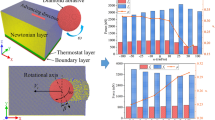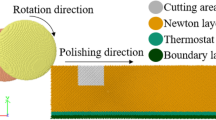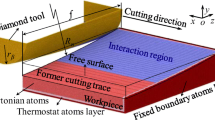Abstract
Molecular dynamics simulation is used to simulate the polishing process of silicon in this paper. Several models such as single abrasive and multi-abrasive are established for simulation analysis. The results show that the greater the height difference between the double abrasives, the greater the polishing force in the machining process, resulting in higher surface bulge and deeper underground damage after polishing. When polishing with a single abrasive, the polishing depth plays a dominant role in the changes in polishing force, temperature and coordination number. When multiple abrasives are arranged at a certain angle, the force effect and damage distribution are more complex because of the coupling effect of abrasives. Due to the effect of multiple abrasives, the heat between abrasives cannot be dissipated in time. As a result, the temperature of multiple abrasives polishing at a certain angle is higher than that of the other two cases (single abrasive and double abrasives).
















Similar content being viewed by others
Data availability
The data used to support the findings of this study are available from the corresponding author upon request.
Change history
29 July 2022
A Correction to this paper has been published: https://doi.org/10.1007/s00170-022-09853-2
References
Hou ZJ, Ge PQ, Gao YF (2007) The development of a wire saw for wafer slicing of single-crystal silicon. Int J Comput Appl Technol 29(2–4):187–190
Patolsky F, Granot E, Kosloff A, Heifler O (2016) Nanodicing single crystalline silicon nanowire arrays. Nano Lett 16(11):6960–6966
Demant M, Welschehold T, Oswald M, Bartsch S, Brox T, Schoenfelder S, Rein S (2017) Microcracks in silicon wafers I: inline detection and implications of crack morphology on wafer strength. IEEE J Photovolt 6(1):126–135
Xiang Y (2021) The size effects of point defect on the mechanical properties of monocrystalline silicon: a molecular dynamics study. Materials 14(11):3011
Liu B, Xu Z, Chen C, Li R, Liang L (2020) Numerical and experimental investigation on ductile deformation and subsurface defects of monocrystalline silicon during nano-scratching. Appl Surf Sci 528:147034
Kim H, Park S, Kang B, Kim S, Tark SJ, Kim D, Dahiwale SS (2013) Effect of texturing process involving saw-damage etching on crystalline silicon solar cells. Appl Surf Sci 284(11):133–137
Guo X, Zhai C, Liu Z, Zhang L, Jin Z, Guo D (2015) Effect of stacking fault in silicon induced by nanoindentation with MD simulation. Mater Sci Semicond Process 30:112–117
My A, Fpa B, Rong YA, Bd A, Lin ZA, Hw A (2019) Study on the surface damage mechanism of monocrystalline silicon in micro ball-end milling. Precis Eng 56:223–234
He LH, Zhu FL, Liu YH, Liu S (2017) Investigation of machining mechanism of monocrystalline silicon in nanometric grinding. AIP Adv 7(5):055104
Shen J, Zhu X, Chen J, Tao P, Wu X (2019) Investigation on the edge chipping in ultrasonic assisted sawing of monocrystalline silicon. Micromachines 10(9)
Pizani PS, Jasinevicius R, Duduch JG, Porto AJV (1999) Ductile and brittle modes in single-point-diamond-turning of silicon probed by Raman scattering. J Mater Sci Lett 18(14):1185–1187
Zarudi I, Zhang LC, Cheong WCD, Yu TX (2005) The difference of phase distributions in silicon after indentation with Berkovich and spherical indenters. Acta Mater 53(18):4795–4800
Zarudi I, Zou J, Zhang LC (2003) Microstructures of phases in indented silicon: A high resolution characterization. Appl Phys Lett 82(6):874–876
Yan J, Syoji K, Kuriyagawa T, Suzuki H (2002) Ductile regime turning at large tool feed. J Mater Process Technol 121(2–3):363–372
Chen M, Zhao Q, Shen D, Dan L (2005) The critical conditions of brittle–ductile transition and the factors influencing the surface quality of brittle materials in ultra-precision grinding. J Mater Process Technol 168(1):75–82
Kumar RS (2013) A predictive model of the critical undeformed chip thickness for ductile–brittle transition in nano-machining of brittle materials. Int J Mach Tools Manuf 64:114–122
Liu K, Li XP, Rahman M, Neo KS, Liu XD (2007) A study of the effect of tool cutting edge radius on ductile cutting of silicon wafers. Int J Adv Manuf Tech 32(7–8):631
Huo FW, Guo DM, Kang RK (2012) Nanogrinding of SiC wafers with high flatness and low subsurface damage. Trans Nonferrous Met Soc China 22(12):3027–3033
Svobodova-Sedlackova A, Barreneche C, Alonso G, Fernandez AI, Gamallo P (2020) Effect of nanoparticles in molten salts–MD simulations and experimental study. Renew Energy 152:208–216
Kang RK, Guo XG, Guo DM, Jin ZJ (2004) A study of the molecular dynamics simulation in nanometric grinding. Key Eng Mater 257:33–38
Brocail J, Watremez M, Dubar L, Bourouga B (2008) Contact and friction analysis at tool-chip interface to high-speed machining. Int J Mater Form 1(S1):1407–1410
De-Gang LI, Liang YC, Bai QS, Dong S (2008) Molecular dynamics simulation and experiments of nano-indentation of single crystal silicon (111) plane. Nanotechnol Precis Eng 6(4):242–248
Müting J, Bobal V, Vines L, Grossner U (2021) Phosphorus implantation into 4H-SiC at room and elevated temperature. Semicond Sci Technol 36(6):065002
Meng B, Yuan D, Xu S (2019) Coupling effect on the removal mechanism and surface/subsurface characteristics of SiC during grinding process at the nanoscale. Ceram Int 45(2):2483–2491
Zhou P, Shi X, Li J, Sun T, Zhu Y, Wang Z, Chen J (2019) Molecular dynamics simulation of SiC removal mechanism in a fixed abrasive polishing process. Ceram Int 45(12):14614–14624
Dai H, Hu Y, Wu W, Yue H, Duan H (2021) Molecular dynamics simulation of ultra-precision machining 3C-SiC assisted by ion implantation. J Manuf Process 69:398–411
Cheong W, Zhang LC (2000) Molecular dynamics simulation of phase transformations in silicon monocrystals due to nano-indentation. Nanotechnology 11(3):173
Erhart P, Albe K (2005) Analytical potential for atomistic simulations of silicon, carbon, and silicon carbide. Phys Rev B 71(3):035211.28
Merchant ME (1945) Mechanics of the metal cutting process. I. Orthogonal cutting and a type 2 chip. J Appl Phys 16(5):267–275
Kim DE, Oh SI (2008) Deformation pathway to high-pressure phases of silicon during nanoindentation. J Appl Phys 104(1):013502
Hecker RL, Ramoneda IM, Liang SY (2003) Analysis of wheel topography and grit force for grinding process modeling. J Manuf Process 5(1):13–23
Inasaki I (1998) Principles of abrasive processing. Mach Sci Technol 2(1):155–156
Tnshoff HK, Karpuschewski B, Andrae P, Türich A (1998) Grinding performance of superhard abrasive wheels final report concerning CIRP co-operative work in STC G. CIRP Ann Manuf Technol 47(2):723–732
Basuray PK, Misra BK, Lal GK (1977) Transition from ploughing to cutting during machining with blunt tools. Wear 43(3):341–349
Park HW, Liang SY (2009) Force modeling of microscale grinding process incorporating thermal effects. Int J Adv Manuf Tech 44(5):476–486
Liu K, Li XP (2001) Ductile cutting of tungsten carbide. J Mater Process Technol 113(1–3):348–354
Son SM, Lim HS, Ahn JH (2005) Effects of the friction coefficient on the minimum cutting thickness in micro cutting. Int J Mach Tools Manuf 45(4–5):529–535
Shaw MC (1972) New developments in grinding. Proceedings of the international grinding conference, Pittsburgh, Pennsylvania
Goddard J, Wilman H (1962) A theory of friction and wear during the abrasion of metals. Wear 5(2):114–135
Sin H, Saka N, Suh NP (1979) Abrasive wear mechanisms and the grit size effect. Wear 55(1):163–190
Acknowledgements
The authors would like to appreciate the National Natural Science Foundation of China (52105178, 12162008), National Natural Science Foundation of Hunan (2022JJ40056), and Guizhou University cultivation project (Guida cultivation [2020] No. 10).
Author information
Authors and Affiliations
Corresponding author
Ethics declarations
Ethics approval
Ethical approval was obtained from the College of Mechanical Engineering of Guizhou University.
Consent to participate
Not applicable.
Consent to publish
All authors have seen the manuscript and approved to submit to your journal, and we would greatly appreciate for your attention and consideration.
Competing interests
The authors declare no competing interests.
Additional information
Publisher's note
Springer Nature remains neutral with regard to jurisdictional claims in published maps and institutional affiliations.
The original online version of this article was revised: In this paper, the acknowledgements are wrong. Two funding funds have been repeated.
Rights and permissions
Springer Nature or its licensor holds exclusive rights to this article under a publishing agreement with the author(s) or other rightsholder(s); author self-archiving of the accepted manuscript version of this article is solely governed by the terms of such publishing agreement and applicable law.
About this article
Cite this article
Meng, X., Yue, H., Wu, W. et al. Simulation of abrasive polishing process of single crystal silicon based on molecular dynamics. Int J Adv Manuf Technol 121, 7195–7211 (2022). https://doi.org/10.1007/s00170-022-09770-4
Received:
Accepted:
Published:
Issue Date:
DOI: https://doi.org/10.1007/s00170-022-09770-4




